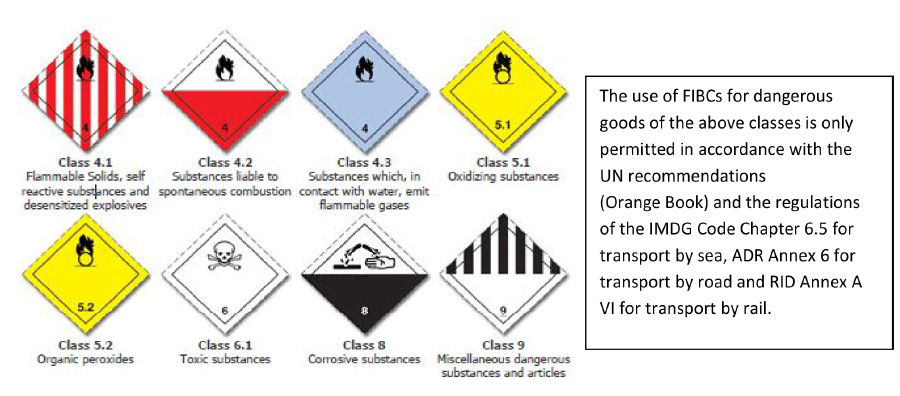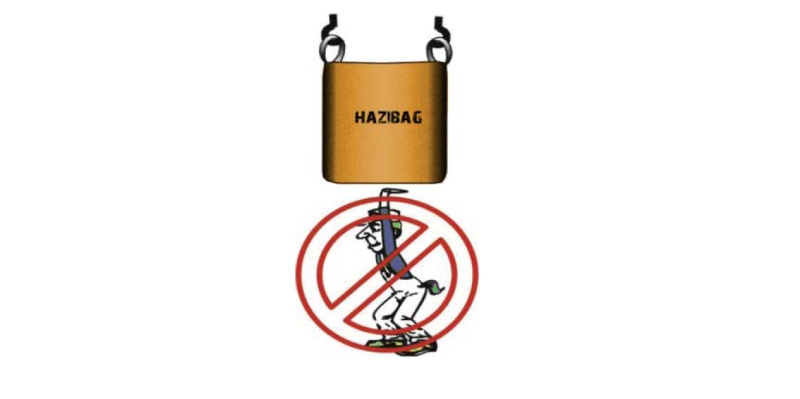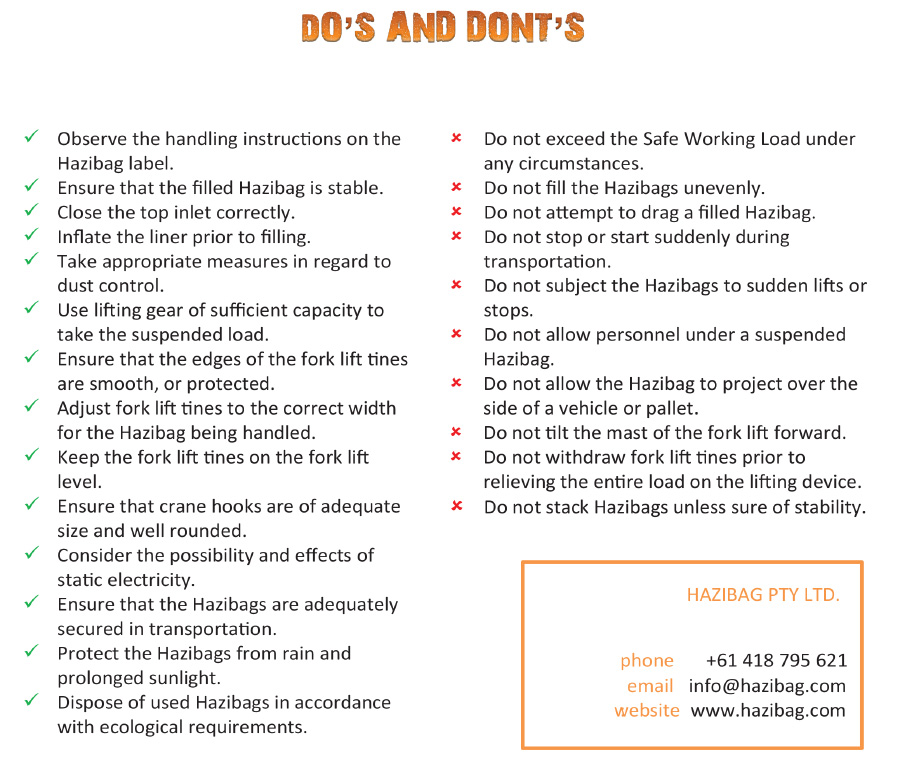HAZIBAG CORPORATE
An award-winning greener, safer, easier and compliant solution for managing Hazardous Waste
Designed as a safer alternative to wrapping and transporting Asbestos, two years of research and testing went into the making of HAZIBAG a Flexible Intermediate Bulk Container (FIBC)
TESTED AND APPROVED
HAZIBAG FEATURES
Released onto the Australian market in 2011, Hazibag is:
** While Hazibag was created with Asbestos in mind, its final certification makes Hazibag also suitable for a variety of other Dangerous Goods and Hazardous Wastes
HAZIBAG DESIGN
Pack, Transport and Dispose of Hazardous Waste
While Hazibag was created with Asbestos in mind, its final certification makes Hazibag also suitable for a variety of Dangerous Goods and Hazardous Wastes including Contaminated Soils, Solid PCBs, Medical Waste, Pharmaceutical waste, Veterinarian Waste, Contaminated timber, Pesticides, Oil Contaminated Materials etc.
TESTED AND APPROVED
HAZIBAG BENEFITS – TRADE
Developed specifically for the fully compliant containment and transportation of solid hazardous wastes, Hazibag offers substantial benefits over traditional containers such as drums, IBCs and wheeled bins.
TESTED AND APPROVED
HAZIBAG BENEFITS – DYI
Developed specifically for the fully compliant containment and transportation of solid hazardous wastes, Hazibag offers substantial benefits over traditional Plastic Bags/wrap and Containers.
HAZIBAG INFORMATION
FAQs
Hazibags are suitable for the transport of Solid Dangerous Goods packing Group II & III.
Hazibags are certified through the National Australian Testing Authority system (NATA) under the UN recommendations for the transport of dangerous goods.
Depending on the size of your dangerous goods/hazardous waste requirements you will find a variety of Hazibag sizes to choose from.
NOTE: Special care should be taken when handling a Hazibag (filled with UN regulated materials). For questions concerning the materials refer to your supplier’s MSDS sheets. Questions concerning the Hazibag should be directed to your Hazibag distributor/contact.

Hazibags are marked in accordance to the UN requirements as follows (see example):

| CODE | MEANING |
|---|---|
| 13 | Flexible Intermediate Bulk Container for solids. |
| H4 | Woven PP fabric coated and inner liner. |
| Y | Approved for Packing Groups II & III. |
| 12 13 | Month and year of manufacture. |
| AUS | Country/State authorizing the allocation of the mark. |
| ZB100 | Name of manufacturer. |
| 20560 | Number of test certificate. |
| 1350 | Max stacking weight in kg. |
| 250 | Max permissible gross weight in kg. |
The empty Hazibag should be kept in its carry bag and stored undercover in a manner to prevent accidental damage and exposure to the elements i.e. sunlight and extreme weather conditions.
Remove Hazibag from the carry bag. Open the Hazibag and fold open each side (half height) until all four sides become rigid. Now open the liner and fold over each side. To fill the Hazibag it is best to place on level ground/area that is strong enough to withstand the weight of a filled Hazibag. When the Hazibag is half, full pull up all four sides in order to finish filling. Once you have filled the Hazibag twist the top of the inner liner around and fold over to form a goose neck. Tape it off. Push the liner down and close the Hazibag lid with the zip. Make sure you do not overfill the Hazibag. When the Hazibag has to be placed outside for filling, care should be taken to protect it from the elements. When the Hazibag is filled should not be dragged and cannot be manually lifted as it will be too heavy. We recommend that if you intend to carry the fill Hazibag yourself and have no access to a fork lift or crane that you preposition the Hazibag to be filled on the back of your truck.
Before lifting always check your Hazibag for possible damage during filling. Always read the handling instructions printed on the Hazibag label. In general the Hazibag should be lifted and lowered vertically and symmetrically, taking care to avoid jerky movements and swinging. Please note that most transport damages occur due to improper handling. Under no circumstance allow any person to be standing or moving below a suspended Hazibag.

The fork lift must be suitable for the load to be carried. When moving loads hanging from the fork lift incorrectly, there is a danger that the fork lift could become unstable. To avoid this care should be taken that the Hazibag is placed close to the mast and as low as possible with the mast tilted slightly backwards. The load should not obstruct the view of the driver and care should be taken that the wheels of the forklift do not damage the Hazibag. The forks should be free of sharp edges to avoid damage to the Hazibag. The forklift should be stopped before the Hazibag is lowered or raised. Hazibags must not be dragged.

Hooks, spreader bars or other devices used for lifting, should have rounded edges and/or protective covers. Hazibag recommends using hooks with a safety latch to prevent accidental slipping off the hook. When the Hazibag is suspended, the loops must be vertical, without any twists or knots.

To right (lift) a Hazibag that has toppled (fallen) on its side, an endless sling, wound through all the lifting loops should be used. Any attempt to right the Hazibag using fewer loops than those provided may result in the loops being torn off.

When transporting Hazibags the cargo must be stowed in a safe and stable fashion. Hazibags must not be stowed together with other cargo boasting sharp edges or can otherwise harm the Hazibag. Legal regulations and recommendation for the transport of dangerous goods must be followed.
When stacking the Hazibags 2 or more high the necessary stability has to be considered and every effort should be made to ensure that the stack is stable. Where possible, Hazibags should be stacked between retaining walls to achieve better stability. When only free stacking is possible, a pyramid shaped stacking is preferable. Never exceed the maximum stacking load of the Hazibag. Hazibags should not be pushed into a stack as this can damage the Hazibag. Moreover, special compression characteristics of the material filled have to be considered when stacking.

FIBCs in principle are not suitable for prolonged storage outside since UV radiation and weather can damage the polypropylene. Hazibags have been treated at the highest possible grade for UV protection. If Hazibags are stored outside, attentions should be paid that the top closure is properly tied off and zipped. It is good practice to cover the Hazibags with waterproof and U.V treated material, to protect the Hazibags from the elements; avoid water collecting on the top and prevent damage from sunlight. Be sure that the Hazibags are not standing in water. It is of the utmost importance to always follow the handling instructions on the Hazibag label.
If the Hazibags are to be filled or emptied in flammable or explosive atmospheres, special features such as antistatic materials should be utilized.
Hazibag is made of grade 4 polypropylene, which is recyclable. By doing this the used material is mechanically processed without changing its chemical structure, and the new recycled material obtained can be reused. Polypropylene has also a high BTU rating and offers high energy potential when incinerated.
HAZIBAG VS COMPETITION (USA)
HAZIBAG CERTIFICATION
There are differences between a standard FIBC bag and a UN Certified bulk bag that make the UN certified bag the right solution for the Hazmat transportation industry:
- UN Certified Bulk Bags have to go through and pass FIBC testing procedures.
- Hazmat bulk bags need to be tagged and labeled clearly and correctly based on the UN requirements.
- UN bulk bags need to meet the requirements on max volume
“All asbestos waste generated must be wetted before it is double bagged in 6-millimeter plastic bags and enclosed in a plastic, leak-tight container with a lid and proper labeling. It can only be disposed of in special landfills that are designated to receive asbestos waste.” Source –https://www.asbestos.com/exposure/handling-disposing-asbestos
Asbestos Bags are heavy grade black garbage bags with warnings printed on the side.

 HAZIBAG has a unique Zippered Top compared to existing FIBCs
HAZIBAG has a unique Zippered Top compared to existing FIBCs